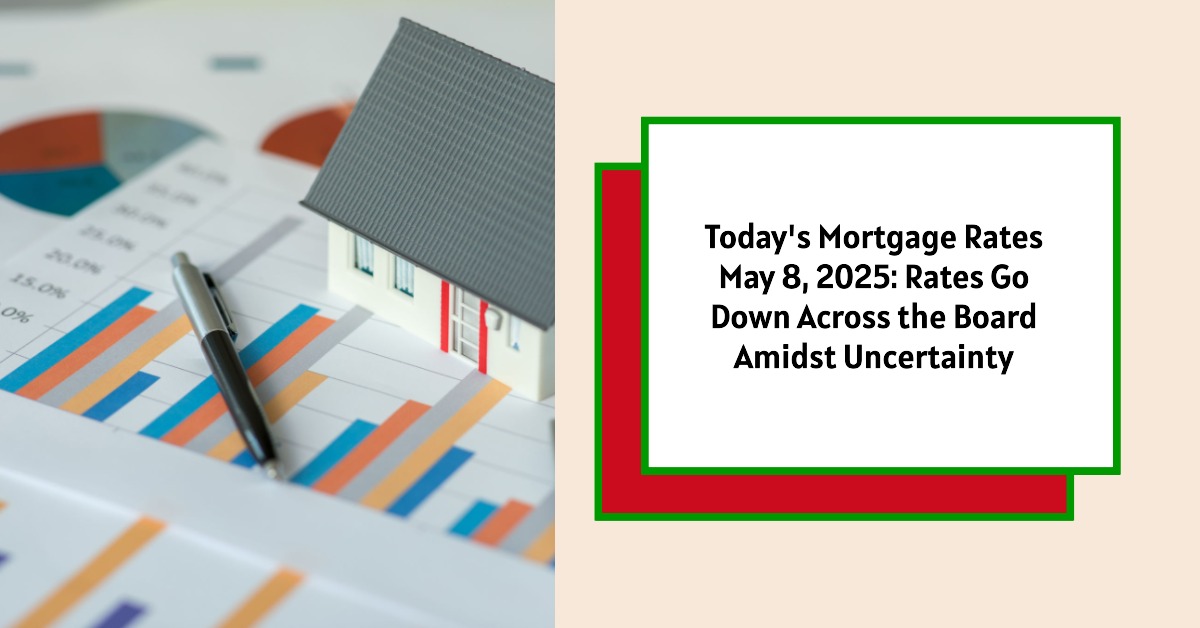As of today, May 8, 2025, prospective homebuyers and those looking to refinance are seeing a welcome, albeit potentially temporary, dip in borrowing costs. According to the latest data from Zillow, today's mortgage rates show a decrease across various loan types, with the widely popular 30-year fixed-rate mortgage averaging 6.69%, a notable 10 basis points lower than the previous day. This slight downward trend also extends to refinance rates, offering a potential window for savings.
Today's Mortgage Rates – May 8, 2025: Overall Decrease Offers a Glimmer of Hope Amidst Economic Uncertainty
Key Takeaways:
- Mortgage Rates Today: The 30-year fixed mortgage rate is at 6.69%, down by 10 basis points.
- 15-Year Fixed Rate: Currently sitting at 5.97%, a decrease of six basis points.
- Federal Reserve Influence: Recent comments from Fed Chair Jerome Powell regarding economic uncertainty are contributing to the volatility in home loan rate trends.
- Refinance Rates: Mirroring the purchase market, refinance rates have also seen a decrease. The 30-year fixed refinance rate is at 6.77%.
- Economic Outlook: The future direction of mortgage rates remains uncertain, heavily dependent on inflation trends and the Federal Reserve's response to potential economic impacts of tariffs.
A Closer Look at Today's Mortgage Rates
The housing market, a cornerstone of our economy, is incredibly sensitive to fluctuations in interest rates. For those of us navigating the journey of buying a home or considering a refinance, understanding the nuances of today's mortgage rates is crucial. Let's delve deeper into the specific rates available right now, based on Zillow's data.
Current Mortgage Rates (May 8, 2025):
| Loan Type | Interest Rate |
|---|---|
| 30-Year Fixed | 6.69% |
| 20-Year Fixed | 6.31% |
| 15-Year Fixed | 5.97% |
| 5/1 ARM | 7.00% |
| 7/1 ARM | 7.24% |
| 30-Year VA | 6.26% |
| 15-Year VA | 5.69% |
| 5/1 VA | 6.33% |
It's important to remember that these figures represent national averages. The actual rate you'll qualify for will depend on a variety of factors, including your credit score, down payment amount, and the specific lender you choose.
Understanding Today's Mortgage Refinance Rates
Just as important as the rates for purchasing a new home are the mortgage refinance rates for those looking to potentially lower their monthly payments, shorten their loan term, or tap into their home equity. As of today, May 8, 2025, these are the following average refinance rates:
Current Mortgage Refinance Rates (May 8, 2025):
| Loan Type | Interest Rate |
|---|---|
| 30-Year Fixed | 6.77% |
| 20-Year Fixed | 6.34% |
| 15-Year Fixed | 5.95% |
| 5/1 ARM | 7.22% |
| 7/1 ARM | 7.10% |
| 30-Year VA | 6.26% |
| 15-Year VA | 5.80% |
| 5/1 VA | 6.28% |
Interestingly, while refinance rates can sometimes be higher than purchase rates, the difference today appears minimal in some categories. This could present an opportune moment for homeowners to explore their refinancing options.
The Dynamics Between 30-Year and 15-Year Fixed Mortgages
When considering a fixed-rate mortgage, the 30-year and 15-year terms are often the most discussed. Both offer the security of a locked-in interest rate for the entire duration of the loan, providing predictability in monthly payments. However, the trade-offs in terms of interest paid and monthly obligations are significant.
A 30-year fixed-rate mortgage is often favored for its lower monthly payments. This can make homeownership more accessible and can free up cash flow for other expenses. However, the longer repayment period means that you will accrue and pay significantly more interest over the life of the loan.
On the other hand, a 15-year fixed-rate mortgage comes with a lower interest rate compared to its 30-year counterpart. While the monthly payments will be higher due to the shorter repayment timeline, you'll end up paying considerably less interest in the long run and own your home in half the time. For example, on a $300,000 loan, the difference in total interest paid between a 30-year loan at 6.69% and a 15-year loan at 5.97% would be substantial – a difference that could equate to tens of thousands of dollars.
The choice between a 30-year and a 15-year mortgage often comes down to individual financial circumstances and priorities. Are lower monthly payments the primary concern, or is minimizing long-term interest costs and achieving faster ownership the goal?
How Mortgage Rates Function: A Simple Explanation
At its core, a mortgage interest rate is the cost you pay to borrow money from a lender to finance your home purchase. It's expressed as a percentage of the loan amount and is a key factor in determining your monthly mortgage payments. There are two main types of mortgage rates: fixed and adjustable.
A fixed-rate mortgage provides stability. The interest rate remains the same for the entire loan term. So, if you secure a 30-year mortgage at 6.69% today, that rate will not change over the next three decades, unless you decide to refinance or sell your home. This predictability can be very appealing for budgeting and long-term financial planning.
An adjustable-rate mortgage (ARM), on the other hand, starts with a fixed interest rate for a specific period (e.g., 5 years in a 5/1 ARM) and then adjusts periodically based on prevailing market conditions. While ARMs may offer a lower initial interest rate, there's a risk that the rate could increase in the future, leading to higher monthly payments. The 5/1 ARM, for instance, has a fixed rate for the first five years, after which the rate adjusts once per year for the remaining 25 years of the loan term.
It's also worth noting that in the early years of a mortgage, a larger portion of your monthly payment goes towards interest, with a smaller amount allocated to the principal (the original loan amount). Over time, this ratio shifts, and you start paying more towards the principal and less towards interest.
Read More:
Mortgage Rates Trends as of May 7, 2025
Fed's Decision Signals Mortgage Rates Won't Go Down Significantly
When Will the Soaring Mortgage Rates Finally Go Down in 2025?
Navigating the Uncertainty: Mortgage Rate Predictions for 2025
Predicting the future of mortgage rates is akin to forecasting the weather – many factors are at play, and accuracy beyond the immediate short term can be challenging. However, analyzing current economic indicators and expert opinions can provide some insights.
As highlighted by Fed Chair Jerome Powell's recent statements, the current economic climate in the U.S. is marked by uncertainty [Zillow]. The potential impact of tariffs on inflation is a significant concern. If tariffs lead to higher inflation, the Federal Reserve might be hesitant to lower its benchmark federal funds rate. This, in turn, could keep mortgage rates from declining significantly.
Conversely, if the economy experiences a slowdown, the Fed might be inclined to lower interest rates to stimulate growth, which could lead to lower mortgage rates.
Fannie Mae's recent forecast offers a glimpse into potential future trends. They project that mortgage rates will gradually decline, with rates potentially ending 2025 around 6.2% for the 30-year fixed mortgage and falling further to 6.0% by the end of 2026. However, this forecast hinges on the assumption that inflation will eventually moderate, allowing the Federal Reserve to implement rate cuts. Fannie Mae anticipates only one rate cut in September 2025, followed by two more in 2026.
Powell himself acknowledged that the Fed is in a “good place to wait and see” how the economic situation unfolds. This suggests that significant swings in mortgage rates are unlikely in the immediate future, pending more concrete data on the impact of tariffs and overall economic performance.
For those of us in the market for a home or considering refinancing, this period of uncertainty underscores the importance of staying informed and being prepared for potential fluctuations in home loan rate trends. While today's decrease offers a positive sign, the broader economic picture suggests that we should remain vigilant and adaptable in our financial planning.
Turnkey Real Estate Investment With Norada
Investing in real estate can help you secure consistent returns with fluctuating mortgage rates.
Despite softer demand, smart investors are locking in properties now while competition is lower and rental returns remain strong.
HOT NEW LISTINGS JUST ADDED!
Speak with an investment counselor (No Obligation):
(800) 611-3060
Also Read:
- Will Mortgage Rates Go Down in 2025: Morgan Stanley's Forecast
- Expect High Mortgage Rates Until 2026: Fannie Mae's 2-Year Forecast
- Mortgage Rate Predictions 2025 from 4 Leading Housing Experts
- Mortgage Rates Forecast for the Next 3 Years: 2025 to 2027
- 30-Year Mortgage Rate Forecast for the Next 5 Years
- 15-Year Mortgage Rate Forecast for the Next 5 Years
- Why Are Mortgage Rates Going Up in 2025: Will Rates Drop?
- Why Are Mortgage Rates So High and Predictions for 2025
- Will Mortgage Rates Ever Be 3% Again in the Future?
- Mortgage Rates Predictions for Next 2 Years
- Mortgage Rate Predictions for Next 5 Years
- Mortgage Rate Predictions: Why 2% and 3% Rates are Out of Reach
- How Lower Mortgage Rates Can Save You Thousands?
- How to Get a Low Mortgage Interest Rate?
- Will Mortgage Rates Ever Be 4% Again?



